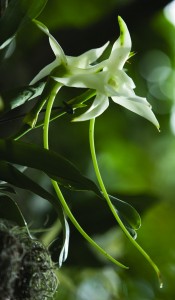Tip of the Week: Darwin and Orchids
Posted in Gardening Tips, People, Science on April 5 2010, by Sonia Uyterhoeven
 |
Sonia Uyterhoeven is Gardener for Public Education. For hands-on demonstrations and orchid tips, join her in the Conservatory’s GreenSchool every Saturday and Sunday at 2 p.m. throughout The Orchid Show. |
 One of the joys of working at The New York Botanical Garden is that you are surrounded by experts, enthusiasts, and curious minds. The Garden has a large team of talented research scientist who convene on a regular basis to share their work and interests in an in-house seminar series.
One of the joys of working at The New York Botanical Garden is that you are surrounded by experts, enthusiasts, and curious minds. The Garden has a large team of talented research scientist who convene on a regular basis to share their work and interests in an in-house seminar series.
Recently, we were spoiled with the presence of Robbin Moran, Ph.D., Mary Flagler Cary Curator of Botany, who specializes in the study of tropical ferns and lycophytes. But rather than his usual discussions of systematics and pteridophyte matters, he shared with us his recreational reading over the past year: the six books that Charles Darwin wrote after his publication of On the Origin of Species that pertain specifically to the study of botany. Those of you who attended our exhibition Darwin’s Garden: An Evolutionary Adventure in 2008 will remember that the celebrated naturalist was an avid experimenter and committed to the study of botany.
The research and voluminous texts Darwin published subsequent to the Origin of Species was aimed at substantiating his theory of evolution and providing the Victorian-era reader with a multitude of examples and a new frame of reference for understanding the mechanisms at work in the natural world.
 Dr. Moran took us on a literary and experimental journey: With refreshing clarity that comes from his expertise as a botanist and educator, we catapulted through 20 years of Darwin’s botanical research.
Dr. Moran took us on a literary and experimental journey: With refreshing clarity that comes from his expertise as a botanist and educator, we catapulted through 20 years of Darwin’s botanical research.
As the Garden’s exhibition The Orchid Show: Cuba in Flower is winding down this week—it ends Sunday, April 11—I would like to share with you Dr. Moran’s discussion of Darwin’s book On the various contrivances by which British and foreign orchids are fertilised by insects, and the good effects of intercrossing. Looking at how the intimate relationships of orchids and pollinators have evolved over time is a good follow-up to my blog post of last week on pollinators and fragrant orchids.
Most flowers are perfect, having both male and female parts. Since the time of Carl Linnaeus, flowers were thought to fertilize themselves (self-fertilization). The famous taxonomist described the flower as a marriage between “husbands,” (the male parts or stamens) and “wives,” (the female parts, or pistils).
This type of inbreeding posed a problem for Darwin: How would evolution and the process of natural selection be possible without variation that occurs from crossing two different plants? He undertook decades of experiments and observation to study the effects of cross-pollination and self pollination.
In these experiments he discovered that cross-pollination often produces more vigorous plants and that many plants had evolved ingenious ways of ensuring cross-fertilization. This variety (variation) is the engine that drives evolution.
One of the more popular Darwin stories is that of the Madagascan Christmas star orchid (Angraecum sesquipedale). This orchid, sometimes referred to as Darwin’s moth orchid, was a source of speculation since its discovery in 1822.
The orchid has large waxy white, star-like flowers with a pronounced lip and a foot-long spur that projects from the back of the flower. Only the bottom inch of the long spur contains nectar (see photo by TalismanBrolin/TalismanPHOTO).
Since this white orchid had a strong spicy fragrance at night, Darwin hypothesized that it must be pollinated by a nocturnal hawk moth with a proboscis (a tongue) that extended to 12 inches. He was ridiculed by the scientific community until 40 years later such a moth (Xanthopan morgani praedicta) was discovered.
Dr. Moran shared another story that was new to me, one that highlighted Darwin’s skill as a meticulous researcher and a gifted theorist. Darwin studied a native British orchid and discovered that if you stuck a pencil down the throat of the orchid (mimicking the actions of a pollinator) the pollinia (sacs of pollen) would adhere to the pencil (or in nature, the bee).
In the orchid, the pollinia attached itself by a stalk or extension that is hygroscopic (meaning it bends when moisture levels or the levels of humidity change). Darwin discovered that once the pollinia attached itself to the bee it dried out and changed its orientation within 30 seconds.
Once dry, the pollinia (on the bent stalk) are in perfect position to attach to the stigma (the female part of the flower that receives pollen). He also calculated that it takes a bee approximately 30 seconds to fly from one flower to the next to feed on nectar.
Nature has conspired to make outcrossing or cross-pollination a straightforward and affordable endeavor, and in doing so has ensured the rapid exchange of genetic material. Both of these Darwinian tales are about co-evolution. In co-evolution plant and pollinator evolve together—insects or birds getting their reward from the plant’s rich nectar in exchange for the promise of a plant’s increased vigor and variation through cross-pollination.
As far as orchids are concerned—we have known for a long time that they are notoriously promiscuous—it’s why we have so many beautiful complex hybrids. Darwin provides us with explanations as to how it all works.


Very informative article on Darwin and co-evolution relating specifically to orchids.
Thank you.
“Steve”